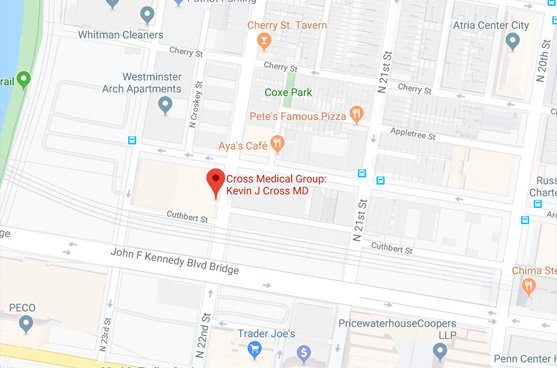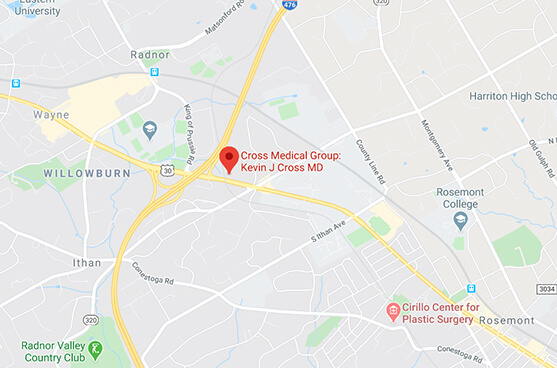Hair Types
Unique Factors to Consider with a Personalized Approach to Hair Restoration
One factor in particular that significantly impacts hair restoration procedures is a patient’s hair type. The Philadelphia-based Cross Medical Group team regularly works with men and women who have a wide range of hair types, from thin and straight to thick and curly.
Understanding the nuances of your hair type can help you with a variety of hair care-related decisions, including which products to use, which hairstyles would suit you best, and which hair restoration treatment would be the most appropriate for you. By considering your specific hair type, tailored solutions can deliver especially natural-looking results.
What Are the Different Hair Types?
Medical and aesthetic professionals in the hair industry generally agree that there are four main hair types: straight, wavy, curly, and coiled. Your hair type is determined by the shape of your follicles. Generally symmetrical and round follicles produce straight hairs. More of an oval or asymmetrical shape produces wavier or curlier hairs.
Of course, there are many cosmetic treatments that can change straight hair to wavy or curly—and vice-versa—but these effects are temporary. Hair type is pretty much fixed and determined by genetics. Keep in mind that it is possible for someone to have variations in hair type on their scalp, as well as on individual hairs. Picture hair that is straight near the scalp but wavy farther down.
That said, most people find that their hair generally falls into one of the four primary categories:
Straight
As the name sounds, this hair type grows in a line without any twists or turns. Straight hair comes in a range of thicknesses, but tends to be oily.
Wavy
Like a relatively calm day at the ocean, wavy hair has the look of motion. Typically falling in a gentle “S,” this hair type is often thicker if the waves are more pronounced.
Curly
This hair type is apparent where hair “loops” back on itself, creating curls that range in diameter from the base of a man’s thumb to a pencil. Frizzing can be a problem.
Coiled
Tight, delicate curls fall into their own category. Coils are often springy and can easily dry out. Like curly hair, regular care is necessary to avoid frizziness with this hair type.
SCHEDULE A CONSULTATION
For more advice about caring for your hair type in Philadelphia, contact the Cross Medical Group by calling (215) 561-9100, or submit a contact form to request a consultation and discuss ways to restore a thicker, fuller head of hair.
What Other Factors Impact Hair Type?
Aside from whether hair is straight, wavy, curly or coiled, there are numerous factors that impact how it grows, looks, feels, and can best be treated.
Porous hair, for example, is better at absorbing elements, whether moisture in the form of water from the air or beneficial products applied directly to the hair itself.
Density is another important factor to consider beyond hair type. This variable describes how many follicles are growing hair on your scalp. Dense hair is abundant and typically creates a thick head of hair with little to no scalp visibility. Less dense hair reveals more skin—whether as a result of naturally low density or loss due to stress, chemicals, or genetic conditions.
Hair may also be anywhere from thick to fine, healthy or damaged, natural to styled, and worn short or long. Hair lines, head shape, and unique elements on the scalp—such as scars—also play roles in determining how hair looks.
Why Does Hair Type Matter for Hair Restoration?
Cross Medical Group works with each patient as an individual, which means our team takes your hair type and various other unique factors into account when developing a hair restoration plan.
Here are some of the common traits associated with different hair types that our team factors into the treatments and procedures:
- Coarser, tightly curled hair that grows in a curved shape: This must be taken into consideration when excising hair grafts for a custom hair procedure, since it can be difficult to see the curved shape beneath the skin. For a natural result, it’s important that the hairline created during the custom hair procedure reflects an appropriate hairline. Hair follicles will need to be transferred correctly to avoid the risk of hyperpigmentation.
- For thick, straight black hair and a lower, wider hairline: It’s important to place hair grafts at low angles to ensure the hair lies straight and appears natural during a custom hair procedure.
What Factors Impact Hair Loss?
Hair-impacting factors outside of our control include genetics, hormones, and more. The presentations of hair concerns also differ among various people.
With this in mind, if you’re considering a custom hair procedure, it can be helpful to know how people from all different backgrounds and hair types lose hair and develop baldness.
There are structural differences in different types of hair, and these differences impact how hair ages, falls out, and is lost in specific patterns. Additionally, hair loss tends to occur at a younger age for some people than others. Custom hair procedures can be tailored to a wide range of hair types and individual needs.
Which Hair Types Benefits Best from a Hair Restoration Procedure?
Patients with any hair type can experience hair thinning and loss—and can benefit from solutions ranging from topical products to surgery. The most important factor for surgery is to have a sufficient number of hair follicles at the donor site that can be transferred to other areas of the scalp. People who lack enough natural hair follicles at the donor sites to be transplanted or are not suffering from pattern baldness may want to consider another option as opposed to a custom hair procedure.
What Are the Details for a Custom Hair Procedure?
With any custom hair procedure, the goal is the same: to create the look of natural, healthy hair growth, no matter the hair type. The main difference between different procedures is in how the hair grafts are positioned on the scalp after they have been harvested. Many variables should be considered when determining how hair should be placed and which implantation techniques should be used.
The first step in any hair transplant surgery is to harvest hair grafts from the patient’s donor area. Hair may be removed using either the strip method or the Follicular Unit Extraction (FUE) method. The strip method for custom hair procedures involves removing a horizontal strip of hair from the donor site and then extracting individual units, while FUE removes the units one at a time. The type of harvesting technique used will depend upon the patient’s unique hair type.
After the hair grafts have been obtained, they are surgically implanted in the balding areas of the head. Before the surgery begins, Cross Medical Group’s team will plan where and how the grafts should be placed to mimic natural hair growth in the patient. Our team will then place each individual graft in the unique, designated pattern. The patient is able to return home after the procedure and should follow all post-operative instructions given.
SCHEDULE A CONSULTATION
Want to learn more about the advantages of various procedures for your hair type in Philadelphia? Get in touch with Cross Medical Group by calling (215) 561-9100, or submit a contact form to request a consultation and discuss ways to restore thicker, healthier hair.








